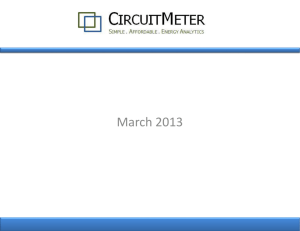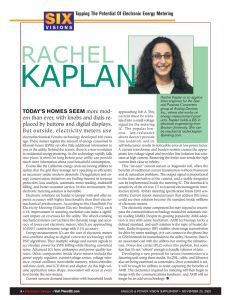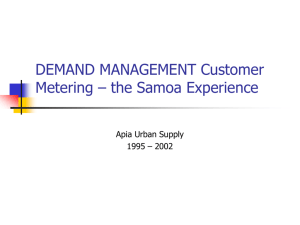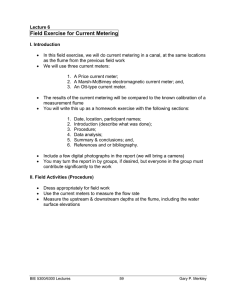Metering Strategy UCL Estates Environmental Sustainability and Engineering, Maintenance & Infrastructure
advertisement
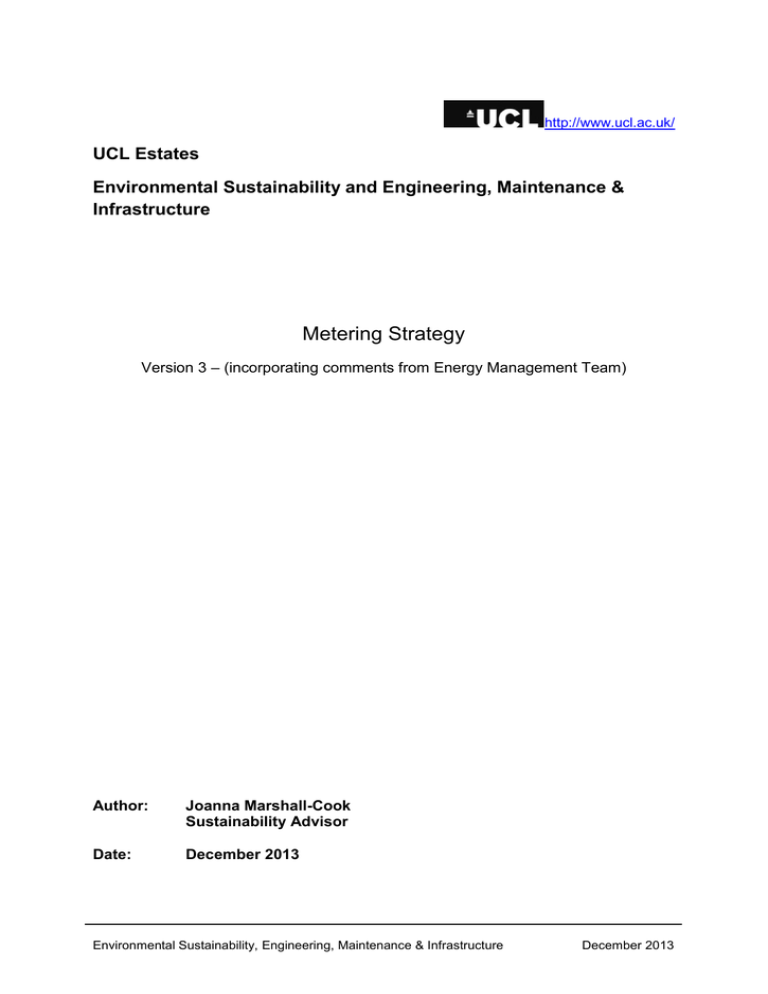
http://www.ucl.ac.uk/ UCL Estates Environmental Sustainability and Engineering, Maintenance & Infrastructure Metering Strategy Version 3 – (incorporating comments from Energy Management Team) Author: Joanna Marshall-Cook Sustainability Advisor Date: December 2013 Environmental Sustainability, Engineering, Maintenance & Infrastructure December 2013 Contents 1.0 Introduction ................................................................................................................ 3 2.0 Objectives of metering ................................................................................................ 3 3.0 Structure of metering proposed .................................................................................. 3 4.0 Current metering situation .......................................................................................... 4 4.1 Heat metering ............................................................................................................. 4 4.2 Electrical metering for buildings on the private wire system ........................................ 4 4.3 Fiscal electricity meters .............................................................................................. 4 4.4 Fiscal gas meters ....................................................................................................... 5 4.5 Water ......................................................................................................................... 5 4.6 Metering for new buildings/ major refurbishments ....................................................... 5 5.0 Overall metering strategy ........................................................................................... 6 6.0 Action plan ................................................................................................................. 7 Environmental Sustainability, Engineering, Maintenance & Infrastructure December 2013 1.0 Introduction UCL’s Environmental Strategy articulates the following aims: 1. To create a campus which supports UCL’s academic, research and enterprise activities in a sustainable way 2. To enable, empower and support all UCL communities to address our environmental sustainability impacts 3. To provide the education, advancement, dissemination and application of sustainable development 4. To maximise the wider impact of UCLs environmental sustainability activities at local, regional, national and international level through collaboration, partnership and communications 5. To become a leader across the HE sector in terms of environmental sustainability. The implementation of comprehensive energy and water metering across the campus will help to achieve these aims by: Helping the Estates department to manage the Estate to reduce carbon emissions and make buildings more comfortable to work in Providing visibility of the energy and water that is being used across campus to facilitate culture change within the UCL community To allow Academics and Students to use the Estate as a living lab for sustainability research by providing appropriate data A metering strategy has therefore been prepared to provide a structure and timeline for improving metering across the campus to achieve these aims. 2.0 Objectives of metering The following objectives for metering at UCL have been identified: Ensure system efficiency Collect data for reporting, regulatory compliance and baselining Inform design and investment decisions Inform infrastructure management Provide visibility/ usability of energy data 3.0 Structure of metering proposed It is proposed that the following tiers of metering are required: 0. 1. 2. 3. University wide (e.g. Satellite Estate, Bloomsbury campus) Building level Floor of each building and central plant (to be confirmed what this level will comprise) Small equipment, e.g. MRI scanners All metering will be approved by EM&I and should be to an EM&I specification (reference to be added once specification is finalised). However, EM&I will only be responsible for the design, installation and maintenance of levels 0-2. An appropriate level of metering for tiers 2 and 3 will be determined on a building by building basis. Environmental Sustainability, Engineering, Maintenance & Infrastructure December 2013 4.0 Current metering situation There are currently the following types of meters installed at UCL: Fiscal gas meters Fiscal electricity meters Fiscal water meters Electricity check meters connected to the EMON system (a centrally monitored system) Heat meters for buildings on the district heating network Sub-metering 4.1 1. 2. 3. 4. 4.2 Heat metering Heat meters are installed in all buildings on the heat network except for Lewis Building, Darwin and Wates House. These missing meters are going to be installed in the near future. A spider diagram showing these meters can be found here. Heat meters are connected to the BMS. Heat meters provide a pulsed output and can therefore be connected to the EMON system. A project has been implemented to ensure that there is heat metering on all the primary plant on the district heat network. This will provide a figure for the efficiency of the district heating system. The spreadsheet showing the result of this work can be found here. From February 2014 a report from the District Heating network will be presented at each Energy Management Team meeting. Electrical metering for buildings on the private wire system 1. For buildings on the Bloomsbury campus that are connected to the private wire system the electricity check meters are the only form of electricity metering. These collect quarter-hourly electricity data, but this could be changed to half-hourly meter readings. A list of the metering that has been installed to date is available here. 2. Electricity check meters are connected to the EMON system (data from the EMON system can be found in this folder). 3. Electricity check meters are not connected to the BMS. 4.3 1. 2. 3. 4. Fiscal electricity meters ~95% of fiscal electricity meters have smart meters attached. We can therefore obtain half hourly data from these meters (for free). Fiscal energy and water data can be accessed through Utilyx and can be provided in a variety of different reporting formats. Fiscal electricity meters are not currently connected to the BMS Historic data (pre mid-2012) is stored in SytemsLink. Environmental Sustainability, Engineering, Maintenance & Infrastructure December 2013 4.4 Fiscal gas meters 1. Most gas meters have smart metering which gives the equivalent of half-hourly meter readings for these meters. However, Gazprom (the gas supplier) charge £70/meter/year to send this data to UCL. 2. Gas meters are not currently connected to the BMS. 3. Historic data (pre 2010) for gas is stored in SystemsLink. 4.5 Water The location of only 75% of the water utility meters is known. Water meters are not currently connected to the BMS All meters are read manually (or estimated) by Thames Water. Meters cannot provide high level of granularity of data – yearly consumption only. 1. 2. 3. 4. 4.6 Sub-metering Sub-metering on a per floor basis, of lighting and other plant has so far been completed as part of refurbishment works (in accordance with Part L of the Building Regulations). It is therefore not uniform across the campus. 4.7 Metering for new buildings/ major refurbishments The specification for metering in new buildings (to address Part L requirements, but also to enable us to monitor energy consumption), requires sub-metering for: Lighting Central mechanical plant End user loads Ancillary loads e.g. lifts This forms part of the Design Brief which can be found here: http://www.ucl.ac.uk/estates/maintenance/design-brief/ Environmental Sustainability, Engineering, Maintenance & Infrastructure December 2013 5.0 Overall metering strategy 1. Connect all heat, gas and electricity metering to the EMON system (probably using half-hourly readings). Meters with a pulsed output (i.e. meters that have smart metering and heat meters) can be interfaced with the EMON system and data can be collected. The EMON system can accommodate any data that is in Modbus format. 2. Decide how the data from these meters will be managed. 3. Connect EMON system to a display interface that allows the whole UCL community to download our energy data in different formats. This then may be connected to another system to provide a better visual display to the average viewer. 4. Complete building level metering (heat, electricity and gas) for buildings where this is missing. 5. Ensure refurbishment and new build projects adhere to metering specification (currently being developed by Chris Marshall) 6. Develop strategy for sub-metering within buildings. This should identify what level of metering is required for different building types. Then implement this strategy. 7. Establish protocol for users/ customer requests for data and metering. Environmental Sustainability, Engineering, Maintenance & Infrastructure December 2013 6.0 Action plan Activity Short term Identify an appropriate structure for metering within buildings (for different types of buildings) and what level of small power needs to be metered. Person Comments Deadline responsible Joanna MarshallCook Draft submetering strategy provided in appendix A Budget Resourcing implications Agreement by end of December 2013. 1 day (JMC) Decide on how buildings should be grouped for the Tier 0 level of metering. Speak to Thames Water as to how we can obtain maps of their water infrastructure to identify where meters are. Joanna MarshallCook End of November 2013 - ½ day (JMC) Martin Earlam MidDecember 2013 ~£1,000 to buy mapping from Thames Water. ½ day (ME) Obtain gas smart meter data for all buildings that have smart metering installed. Identify satellite buildings that do not have appropriate metering in place. Establish topography of high energy use buildings. Ensure that specification for metering for building upgrade work/ new buildings is in line with metering strategy and topography (in particular need to add heat and water David Anderson End of December 2013 £6,500 (£70/ meter/year) 1 day (DA) End of December 2013 - 2 days (JMC and DA) End of January 2014 None CM End of December 2013 None CM Joanna MarshallCook Focussing on energy intensive buildings first Chris Marshall Chris Marshall Specific sections of design guide to be presented to EM&I, Estates & others Environmental Sustainability, Engineering, Maintenance & Infrastructure December 2013 Activity Person Comments Deadline responsible Budget Resourcing implications Rob Durno End of January 2014 Cost of (RD, Nigel additional Oglesby, heat (and NJ) gas?) meters that are required. February 2014 - 1 day (CM, Project managers, framework consultants) June 2014 - 1½ days (CM, Energy Institute, JMC, DA) End of January 2014 - 1 day requirements). Medium term Identify efficiency of district heating system by: 1. Finish installing additional heat meters that are required (on central plant and the buildings). 2. Continue to take weekly meter readings from the heat meters (both on central plant and on each building) 3. Connect heat meters to BMS Run training session with Internal Project Managers and Framework consultants to explain the new metering specification and the design guides. Present to Energy Institute on the new metering infrastructure to help them understand how they can access data for their needs. Establish protocol for user/ customer requests for data and metering. Chris Marshall Members of the Energy Institute could also attend this session if they wish. Chris Marshall Richard Jackson May need to consider how data for sensitive buildings is displayed. Environmental Sustainability, Engineering, Maintenance & Infrastructure December 2013 Activity Person Comments Deadline responsible Dave Tender Anderson document agreed – End of January 2014 Budget Resourcing implications £20,000/ yr 3 weeks (DA, CM, NJ, JMC) Identify where the remaining 25% of our water meters are and take meter readings. It should be noted that many of these meters serve more than one building. Dave Anderson End of February 2014 - 1 week (DA, maintenance team) Provide heat meters for Wates House, Lewis Building and Darwin and connect to BMS. Connect data from electricity check meters, fiscal meters (gas and electricity) and heat meters to the EMON system. Rob Durno February 2014 Cost of heat meters. To be confirmed. (RD, Nigel Oglesby and CHP team) This will need to consider how the data is structured to ensure that people can obtain the data. To be confirmed To be confirmed Initial focus will be the most energy intensive buildings. ~ 136 meters, cost to be confirmed (CM and Elect team) July 2014 -(paid for by utility providers) 1 week (DA) Dec 2014 ~£150,000 8 weeks (JMC, DA, Decide on the most appropriate display software for data to various audiences and implement the system showing the four tiers of data. Chris Marshall Long term projects Install electrical Chris check meters to the Marshall buildings that do not currently have their own meter. Continue process of upgrading gas and electricity meters across the site to smart meters. Implement programme of sub- It would be worth joining with the work going on to address legionella issues in terms of water meters. Dave Anderson Joanna Marshall- Focussing on most Environmental Sustainability, Engineering, Maintenance & Infrastructure December 2013 Activity metering in buildings as per spec developed for different building types. Implement metering programme at Satellite sites. Person Comments Deadline responsible Cook energy intensive buildings first Budget Resourcing implications CM, NJ,) Joanna MarshallCook ~£15,000 Focussing on most energy intensive buildings first Dec 2014 Environmental Sustainability, Engineering, Maintenance & Infrastructure 8 weeks (JMC, DA, CM, NJ,) December 2013 Appendix A: Ideas for the Sub-Metering Strategy Labs Metering by floor: Heating Pumps + fans (motor control centres) Cooling Lighting Computer/server rooms Small power (through virtual metering) Domestic hot water (virtual) Water Equipment Ovens Autoclaves Centrifuges MRI scanners Mass spectrometers Environmental chamber Offices (per building) Lighting Chillers Pumps + fans (motor control centres) Heating BSUs Heating Pumps + fans (motor control centres) Lighting Cooling Small power (through virtual metering) Domestic hot water (virtual) Humidifiers/ dehumidifiers Catering Heating Chillers (for cold stores too) Lighting Small power (through virtual metering) Domestic hot water (virtual) Water Equipment: Ovens Environmental Sustainability, Engineering, Maintenance & Infrastructure December 2013 Fridges Lecture theatres Lighting Heating Chillers (for cold stores too) Student residences Lighting Heating Catering (see below) Small power (virtual) Art/ studio space Computer rooms Video suites Workshops Observatories Telescopes Data centres Cooling All other power (potential meter power conversion) Libraries Lighting Chillers Pumps + fans (motor control centres) Heating Engineering Concrete crushers ???? Environmental Sustainability, Engineering, Maintenance & Infrastructure December 2013 Individual pieces of plant (in line with Building Regulations) Boiler installations/CHP plant >50kW Chiller installations >20kW Electric humidifiers >10kW Final electrical distribution boards >50kW Motor control centres (power to fans/pumps) >10kW Environmental Sustainability, Engineering, Maintenance & Infrastructure December 2013 Fig 3 – Plan-Do-Check-Act cycles for UCL HV System Statutory Compliance Environmental Sustainability, Engineering, Maintenance & Infrastructure December 2013
